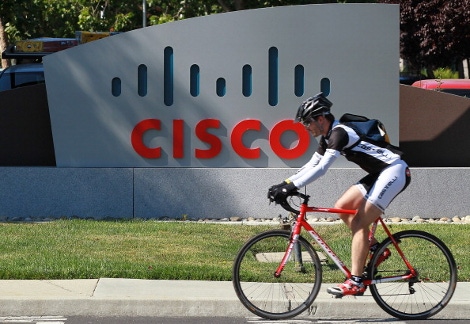Cisco Signals Success in Focus Shift from Hardware to Software
Optimistic forecast indicates strategic focus on software to compensate for slumping hardware sales is paying off
May 19, 2016

(Bloomberg) -- The shares of Cisco Systems jumped the most in three months after quarterly sales and profit forecasts exceeded analysts’ estimates, an early sign that it’s staying ahead of shifts in the networking industry that threaten its lucrative hardware business.
Growth is being driven by newer units such as security and conferencing, divisions that Cisco has built up in recent years through acquisitions. The company late Wednesday projected sales growth of as much as 3 percent in the current period, while analysts had predicted revenue would decline. Fiscal third-quarter results also topped estimates, sending the stock up as much as 5.9 percent.
CEO Chuck Robbins is trying to accelerate growth by shifting the company’s offerings toward software-based networking, security and management products, which customers increasingly prefer because they’re less expensive and more adaptable. Recent acquisitions such as Jasper Technologies, whose software allows companies to connect all sorts of electronic devices, and a new emphasis on security are helping make Cisco less dependent on its expensive, purpose-built hardware, especially as lackluster economic growth means corporate customers are reluctant to spend.
“We’re in the early days of this transition, but I think we’ve proven in those businesses that we can actually make this transition, and we now have a plan underway to take that methodology across the balance of our portfolio,” Robbins said in an interview Thursday morning.
The company still has a long way to go to recast itself fully, and earnings are not where they should be, Robbins said Wednesday after the earnings results were released.
Software Takeover
Profit before certain costs in the period that ends in July will be 59 cents to 61 cents a share, and revenue may rise as much as 3 percent, the company said in a statement, indicating sales as high as $13.2 billion. That compares with average analyst projections for profit of 58 cents a share on $12.4 billion in sales, according to data compiled by Bloomberg.
“The market was braced for them to miss and they put up decent results, not great,” said Mike Genovese, an analyst at MKM Partners. “They’re facing up to the reality that hardware is not a growth market. Software is taking over.”
Cisco’s shares, down 1.6 percent this year through Wednesday, jumped to as high as $28.29 Thursday, the biggest increase since February, and were trading at $27.91 at 9:51 a.m. in New York.
In the third quarter, which ended April 30, Cisco’s net income fell to $2.35 billion, or 46 cents a share, from $2.44 billion, or 47 cents, a year earlier. Sales fell 1.1 percent to $12 billion. Excluding some costs, profit was 57 cents, compared with an average analyst estimate for profit of 55 cents on revenue of $11.98 billion.
Cisco’s upbeat forecast, given a month after most other technology companies gave their own quarterly predictions, may indicate that spending on networking improved in April after a weak first three months of the year. Rival Juniper Networks last month said corporate customers and telecommunications providers had cut back on orders in the calendar first quarter, leading to lower-than-predicted profit and revenue. Cavium, a chipmaker that counts Cisco as its biggest customer, reported sales that fell short of its forecast.
“With Cisco being off by a month, they may be able to call out if things started improving in April,” said David Heger, an analyst at Edward Jones & Co. “That could be a new data point for the market.”
Hardware Declines
Cisco’s biggest division, switching, had third-quarter sales of $3.45 billion, a decline of 3 percent from a year earlier. Its second-largest division, routing, suffered a 5 percent drop in sales to $1.89 billion, the company said. Newer units including security, service-provider video and collaboration all posted sales increases of more than 10 percent.
Gross margin, or the percentage of sales remaining after deducting costs of production, widened to 65.2 percent in the recent quarter from 62.5 percent a year ago.
Robbins, who took the top job at Cisco last year, is trying to return the company to the double-digit percentage growth the company delivered under his predecessor, John Chambers. Cisco hasn’t achieved that since 2010, and analysts don’t project that rate of expansion in the coming years, as the networking market turns away from the combinations of locked-down custom software and hardware that were once so successful.
Robbins has said the company is rapidly transforming its product line to fit changing customer requirements ahead of any full-scale shift. Regardless of whether it makes that move fast enough, some analysts are betting Cisco’s reserves of cash and equivalents -- which stood at $63.5 billion at the end of the latest quarter -- means the company can protect itself by acquiring any smaller rival that’s an emerging leader in technology that could undermine Cisco’s position in the broader networking industry.
“The balance sheet they have, they can keep buying themselves into areas that are growing,” said Edward Jones’s Heger. “They can at least buy their way into keeping things stable.”
About the Author(s)
You May Also Like



.jpg?width=700&auto=webp&quality=80&disable=upscale)



